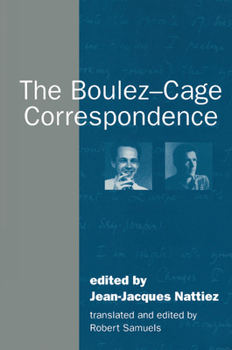The Boulez-Cage Correspondence
Select Format
Select Condition 
Book Overview
Between May 1949 and August 1954 the composers Pierre Boulez and John Cage exchanged a series of remarkable letters that reflect on their own music and the culture of the time. This correspondence, together with other relevant documents, has been edited and annotated by Jean-Jacques Nattiez and is now available for the first time in English in a paperback edition.
Format:Paperback
Language:English
ISBN:0521485584
ISBN13:9780521485586
Release Date:January 1995
Publisher:Cambridge University Press
Length:188 Pages
Weight:0.60 lbs.
Dimensions:0.5" x 6.1" x 9.1"
Customer Reviews
1 rating
the early seeds of modernity discussed in brief letters.
Published by Thriftbooks.com User , 24 years ago
John Cage was the first to introduce Pierre Boulez to the United States. In New York he took Boulez around visiting painters and musicians, this was the early Fifties. David Tudor(long a Cage friend) was performing Boulez's Second Piano Sonata for the first time. Bookstores were frequent stops and Boulez( we learn) never heard of the poet e.e.cummings, and bought a modest book of his poetry. Some thirty years later Boulez set a text of cummings for 22 unaccompanied voices. This correspondence was between two innovators coming from radically different places yet stopping at the same conceptual places. And it is a shame that this friendship fell out quickly,each going into radically different venues. Boulez although fascinated with chance procedures(which Cage had been working with the I Ching, Book of Changes at that time) Boulez was arrongantly fascinated by the aesthetic object,its history and attenuation, and has remained so since. This correspondence has frequent entries on the concept of indeterminacy, again Boulez comes to it via Mallarme, and aleatoric thinking, the throwing of the dice.Boulez sought a musical structure that contained the element of chance as in his Third Piano Sonata in the latter Fifties. Both however were at a creative place in modernity when the Western canon of structure and comprehensibility was falling itself.However it is odd for Boulez to this day thinks of his work as moments containing a "freedom" of something, when he conducts Mahler, he thinks of those passages that are freer than others,like a symphony is a dialogue between the two. Mahler's Sixth Symphony is the case in point. There are letters of Boulez to Cage, while in South America with the Barrault Theatre Company, one entry includes a description from Boulez that he is having a good time "milhauding" around, referring to Darius Milhaud the composer who frequently utilized folk elelments in his music by collecting them in volumes.Nattiez is a very sympathetic observer to this cause of modernity and the roots of things.




